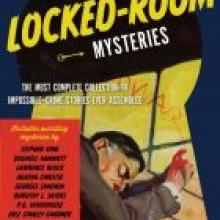
If you have a spare $US250,000 lying around in housekeeping, you could buy a pristine 1843 copy of Prose Romances (if it can be found), in which was published Edgar Allan Poe's The Murders in the Rue Morgue.
This was the very first ''Locked-Room Mystery'' and the template for 170 years of mystery fiction.
However, the better choice, and less damaging to the housekeeping budget, is The Locked-Room Mysteries, ''the most complete collection of impossible-crime stories ever assembled''.
An anthology of 68 short stories written by some of the top names in crime fiction, its first tale is The Murders in the Rue Morgue.
''Locked Room'' is a catch-all phrase and doesn't necessarily refer to a locked room, but rather means the telling of a crime, nearly always a murder, that appears to be impossible.
For example, the body of a murder victim lying in a snow-covered field with two sets of footsteps leading to the victim but none returning.
Or a man who disappears from a locked, moving vehicle.
A verbal conjuring act as it were, where the writer, like a magician, demonstrates a kind of written sleight of hand that bemuses and amuses.
This type of writing was in its heyday between World War 1 and World War 2, but the Agatha Christie whodunnit is now out of fashion.
The vast majority of the stories in the book were written between 1915 and 1945.
They are real puzzles, not suspense, and about who did it and, sometimes, how.
Editor Otto Penzler confessed in an interview even he has never figured out a single locked-room mystery.
The stories are mind-bending and the short biographies that preface every tale are equally fascinating.
I met many ''old friends'', such as Poe, Chesterton and Doyle, but was surprised to find some other familiar authors I knew, lurking under pseudonyms or known for other activities, such as Edmund Crispin, better known as Robert Bruce Montgomery, composer of the music for many British motion pictures, including six Carry On films.
Or Jaques Futrelle, who at 37 took a romantic cruise on the Titanic and who, after the collision with an iceberg, ushered his wife to safety, while he stayed and perished with other victims of the tragedy.
Then there were the two Brooklyn cousins, Dannay aka Nathan and Lee aka Leposky, who collaborated under the name of Ellery Queen, being both their pseudonym and the name of their detective.
Lee went on to found Ellery Queen's Mystery Magazine in 1941, in which many of the ''Locked-Room'' stories first appeared.
• Ted Fox is an online marketing and social media consultant.











